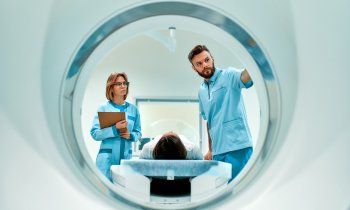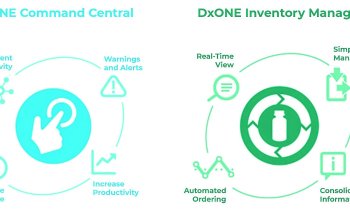by Alisa Gean (published by H&HN Daily)
Preparing for Mass Casualties
The threat of disaster is growing - take lessons from the military to ensure that your hospital is ready
The risk of terrorist attacks, nuclear-radiological hazards, power outages and epidemic-pandemic infections as well as earthquakes, hurricanes, tsunamis and fires are increasing worldwide. Mass casualty incidents, or MCIs, provide a constant reminder of why hospitals need a plan in place to be able to function optimally during and after a catastrophe.

Between 1983 and 2002, there were 36,110 bombing incidents, including the attacks of Sept. 11, 2001. The magnitude of the attack on the World Trade Center made it the worst human-made disaster in the history of the United States. As a result, America went to war and U.S. hospitals began an intense focus on emergency preparedness and disaster response.
MCIs create a large number of casualties in a short period of time, placing tremendous strains on medical resources. In the 2004 Madrid commuter train bombing, there were more than 2,000 casualties, and the closest hospital received 272 patients in less than two hours. MCIs create particular challenges for any medical system that can quickly overwhelm local facilities.
Although hospitals always have been expected to offer a safe environment during disasters, many may become unusable. Hospital leaders say that they have implemented planning and practice drills to help them handle the rush of patients. But there are still challenges and, sadly, according to the Centers for Disease Control and Prevention, only 67 percent of American hospitals have plans in place for all of the above-mentioned hazards. Banks and airports may close in calamitous times, but the public expects hospitals to remain open - especially during disasters.
Lessons from War
One of the few good things about war is that it forces us to develop higher standards of trauma care. Hippocrates wrote, "He who would become a surgeon should join an army and follow it." William Mayo, M.D, said, "Medicine is the only victor in war." In contrast to most civilian physicians, the military is exquisitely trained to execute emergency plans for large-scale disasters. Using five hospital examples, I would like to point out the "good," rather than the "bad and ugly" that has resulted from the recent conflicts in Iraq and Afghanistan.
Emergency response (Who's in charge?)
The military's carefully choreographed medical system has advised civilian health care personnel in both pre-hospital and in-hospital acute care. Terrorism and MCIs at home must be viewed as predictable surprises. Therefore, a well-defined, planned hierarchy will facilitate patient triage and treatment.
All health care personnel should learn about the National Response Framework and the local incident command system to understand the larger picture at the national, state and regional levels. Whether it's an overturned school bus, a hotel fire or a terrorist attack, the on-scene incident commander manages all disasters locally. Do you know who that is at your facility? Your hospital also should have a dedicated command center with restricted access to a defined set of leaders. Do you know where that is and who they are?
Improved hospital triage
Unfortunately, even without a disaster, emergency department crowding continues to be a major problem in the United States. Many hospitals now operate at full capacity and lack the ability to handle a sudden increase in volume associated with mass casualties. Less than half of hospitals have programs in place to accommodate the needs of children and persons with disabilities during a public health emergency.
Although the initial triage of the wounded is funneled to the ED, the first bottleneck in patient diagnosis often occurs at the CT scanner. Thus, a busy radiology department needs to increase patient throughput (via abbreviated imaging protocols) and rapidly make room for newly arriving casualties. A second wave of casualties should be anticipated because patients may have been sent inappropriately to hospitals without trauma facilities.
The sudden increase in volume and the aftermath of an MCI is chaotic, disorganized and unpredictable, and care often is provided by sleep-deprived, stressed-out doctors. Patients may be physically unable to provide critical information about their medical history or simply too confused to provide it, so a working electronic health record system is critical for triage. Finally, the hospital isn't just a place for the injured; it is also a refuge for those fleeing the disaster, and thus becomes part of the disaster.
Maintaining hospital function
War emphasizes the need to secure hospital facilities, erect a temporary field hospital, construct an interim hospital and have a plan for a replacement facility. Power, water and communication systems all can be damaged. Even with auxiliary power, some systems may go offline temporarily, or such services as CT scans may be suspended.
The American College of Emergency Physicians recommends that hospitals develop preparedness plans to ensure adequate inpatient surge capacity by such means as opening unused areas; doubling up inpatient rooms; and establishing alternate care areas in nonclinical space, in decommissioned ward space or inpatient hallways. Conversion of inpatient units to augment ICU capacity and canceling elective admissions and procedures is also an option.
As in war, preservation of the supply chain of nutrition, fluids and critical drugs is paramount. Drug shortages currently complicate health care in the United States, and this problem exists even in the absence of a large-scale disaster.
Improved communication between health care personnel
The wars in Iraq and Afghanistan were the first to use teleradiology, computerized patient tracking and a Web-based patient registry. Hospital information systems are more complex than ever, and reliance on information technology is firmly entrenched in organizational success. Backup and recovery mechanisms are essential. Hospitals should conduct a detailed evaluation of the emergency power system that includes all system-related components.
It is critical to distribute reliable, concise and actionable messages quickly to health care providers. Pagers, satellite and multichannel-access walkie-talkie systems are most reliable. Cell phone communication is less reliable, especially during a disaster, and unexpected heavy call volume may quickly jam cellular networks.
Using social media (e.g., texting, tweeting, YouTube) before, during and after disasters didn't exist a decade ago. But today, mobile apps can provide ED wait times as well as census data to gauge the strain of the health care system. GPS-linked mobile apps can divert patients to facilities with sufficient resources; and off-duty personnel can broadcast their professional background and willingness to help during emergencies.
Practice makes perfect. The unpredictable nature of terrorism and MCIs makes preparation key. Nothing teaches disaster preparedness like experience. Physicians need to be familiar with the unique spectrum of injuries inflicted by blasts that fall outside their routine practice. Emergency response practice can uncover weaknesses in the system and fix it so it doesn't happen again. All departments should know their assigned roles in advance. Has your department performed practice drills? Hospital leaders should think two to three steps ahead and constantly look at all of the what-ifs. In a disaster situation, there is no time for what-ifs.
Emergency responders play different roles in the rescue operation, but there is one commonality: the importance of communication, collaboration and action. Hospitals should strive to automate emergency plans and protocols, and perform exercises until staff members know how to respond reflexively.
Be Prepared
Public health preparedness has improved by leaps and bounds since that fateful day in September 2001. While war has its horrendous side, it has always advanced medical care. And it has uncovered opportunities to go beyond the danger of an immediate situation, benefiting medicine during future disasters.
Profile
Alisa Gean, M.D., is a professor of neuroradiology and adjunct professor of neurology and neurological surgery at the University of California at San Francisco and San Francisco General Hospital. She is the author of Brain Injury: Applications from War and Terrorism (Lippincott Williams & Wilkins, 2014).
22.08.2014








